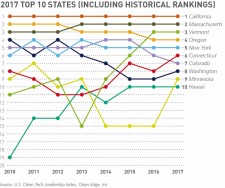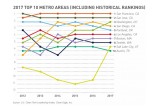States and Cities Lead Clean Energy Transition in the Age of Trump

Portland, Oregon, May 16, 2017 (Newswire.com) - Clean Edge, Inc. today released its eighth annual U.S. Clean Tech Leadership Index, which tracks and ranks the clean-energy activities of all 50 states and the 50 largest metro areas in the U.S. As the Trump administration works relentlessly to dismantle climate and environmental protections and forwards a pro-fossil-fuel, climate-change-denial narrative, this year’s Index shows that states and cities are playing an outsized role in the expansion of clean energy, transportation, and energy efficiency. A free downloadable summary report of this year’s Index is available at www.cleanedge.com.
In 2016, wind and solar power represented 61% of all new electricity generating capacity installed in the U.S. for the second year in a row. This dramatic transition away from fossil fuels (particularly coal) for new power sources is having a significant impact on state-level generation mix. Three states (Iowa, South Dakota, and Kansas) now generate 30% or more of their electrons from utility-scale wind, and another three states exceed 20% renewables (Oklahoma and North Dakota from wind and California from wind, solar, and geothermal). These leaders are politically diverse, with the top 10 states for renewable electricity generation including five red states and five blue states.
"Declining costs for solar and wind are the key driver fueling renewables' rise. In many regions around the nation, utility-scale onshore wind and solar, even without subsidies, now beat coal, nuclear, and even combined-cycle natural gas on cost for new generation assets."
Ron Pernick, Clean Edge Managing Director
“Declining costs for solar and wind are the key driver fueling renewables’ rise,” says Clean Edge managing director Ron Pernick. “In many regions around the nation, utility-scale onshore wind and solar, even without subsidies, now beat coal, nuclear, and even combined-cycle natural gas on cost for new generation assets.”
The clean energy jobs metric (measured as a percentage of a state’s total workforce) is a new indicator in this year’s Index. A total of 2.4 million jobs nationwide (including those in solar, wind, and hydro generation; ethanol and biomass fuels; storage and smart grid; and energy efficiency) reflect the economic vitality of the sector. Solar and wind power generation jobs (473,881 combined nationwide), for example, now outpace jobs in natural gas electric power generation (362,118) and coal power generation (160,119). Top states for clean energy jobs include Vermont, Rhode Island, Utah, Michigan, Oregon, and Massachusetts.
Overall State Index Results
California and Massachusetts top the rankings once again. California has finished first in the Index in all eight years of its existence and Massachusetts garners its fifth consecutive second-place finish, with Vermont, Oregon, and New York finishing third through fifth with repeat performances. Rounding out this year’s top ranking states are Connecticut, Colorado, Washington, Minnesota, and Hawaii. Minnesota is this year’s big mover into the top 10. The Land of 10,000 Lakes makes a return visit with a six-spot leap to #9.
Overall Metro Index Results
San Francisco and San Jose remain the respective leaders in this year’s Index, as they have for the past five years. Washington, DC, makes a two-spot jump up to third. San Diego (#4) and Portland (#5) each slide one spot, while Los Angeles holds steady at #6. Boston once again snags the seventh spot, and is followed by three metros that are virtually tied in overall scores: Seattle, Salt Lake City, and Austin. Salt Lake City, which joins the leaderboard for the first time, joins four other top 10 Index leaders (Portland, San Diego, San Francisco, and San Jose) in having a 100% RE goal in place.
About the U.S. Clean Tech Leadership Index
Sponsors of the 2017 U.S. Clean Tech Leadership Index include lead partner Wells Fargo and supporting partners Cleantech San Diego, Connecticut Green Bank, Massachusetts Clean Energy Center, Portland Development Commission, Texas Sustainable Energy Research Institute, and the World Resources Institute. In addition to publicly available datasets and Clean Edge-derived indicators, Clean Edge leverages data from private data partners including Cleantech Group; EQ Research; Heslin Rothenberg Farley & Mesiti P.C.; IHS Markit; and the North Carolina Clean Energy Technology Center.
Complete state and metro datasets are only available to Index partners. For information on subscription packages, contact Bryce Yonker, Clean Edge Director of Business Development, at 503-522-6101 or yonker@cleanedge.com
About Clean Edge
Clean Edge, Inc., founded in 2000, offers a suite of indexes, surveys, and advisory services for corporate, government, NGO, utility, and financial clients working to transition to a clean-energy, low-carbon economy. Products and services include multiple clean-tech stock indexes in partnership with NASDAQ, the U.S. Clean Tech Leadership Index (tracking state and metro activity), the Grid Modernization Index in partnership with GridWise Alliance, and webinars and events that regularly convene hundreds of industry innovators and stakeholders. www.cleanedge.com
Additional artwork and tables from the report (such as the jobs table below) are available to the media upon request.
Media Contact: Ron Pernick - Managing Director - pernick@cleanedge.com - 503-493-8681
Source: Clean Edge, Inc.



